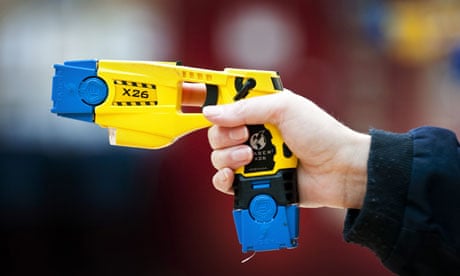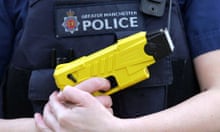Taser is a brand name for a type of electrical stun gun that is licensed, in the UK, for exclusive use by police and military personnel. Police can use one of two Taser weapons in England and Wales: the M26 and the X26.
The commonly used version looks like a handgun and uses compressed nitrogen canisters to project a pair of darts towards a suspect. When these are embedded in a person, the Taser delivers a 50,000v electric shock through wires connecting the darts to the handheld device.
The 19 pulses of electricity per second stimulate nerves that control muscles and are designed not to affect the heart. The shocks make a person's muscles rigid, dropping them to the ground.
All police in the UK have been able to use the devices since 2008, after a limited field trial in 10 forces.
In the time that UK police have used Tasers, four people have died in incidents involving the weapon.
Around the world, there have been more than 300 deaths in incidents involving Tasers. Direct links between the deaths and the effects of the Tasers themselves, however, have not been proved.
Possible adverse medical effects have been highlighted in case studies over the years, however. In 2006, Amy Sheil at the Medical University of South Carolina in Charleston described how a fit, 28-year-old prisoner had died after getting six Taser shocks, giving him a 169-second burst of electricity.
At the 2007 meeting of the Heart Rhythm Society, Leslie Saxon, a cardiologist at the University of Southern California, showed how the voltage from a Taser could cause arrhythmias in people with pacemakers.
A 2008 report by Amnesty International, which looked at the use of Tasers in US law enforcement, said it was recognised that the strong muscle contractions from Taser shocks can cause "injuries, including sprain-type injuries and compression fractures. Some of these concerns came to light when officers were injured during training, and warnings about such injuries are now included in Taser International's product warning bulletins. The warnings note that such injuries are more likely to occur in people with pre-existing conditions such as osteoporosis or muscle, bone or joint damage."
A 2011 study for the US department of justice on "conducted energy devices" (CEDs) concluded that there was "no conclusive medical evidence in the current body of research literature that indicates a high risk of serious injury or death to humans from the direct or indirect cardiovascular or metabolic effects of short-term CED exposure in healthy, normal, nonstressed, nonintoxicated persons. Field experience with CED use indicates that short-term exposure is safe in the vast majority of cases. The risk of death in a CED-related use of-force incident is less than 0.25%, and it is reasonable to conclude that CEDs do not cause or contribute to death in the large majority of those cases."
Taser International says that the use of the device is not risk free, but it adds on its website: "Independent medical and scientific experts have determined Taser devices to be a safer response to resistance option compared to traditional use-of-force tools."
It also advises police on how to use the technology more safely: "Although recent studies … do not find evidence of substantial risk of cardiac arrhythmias with CED use, it is advisable to avoid discharges directly to the chest when practicable.
"Similarly, it is advisable to avoid prolonged discharges of greater than 15 seconds."



